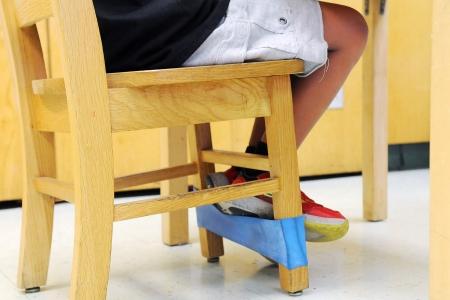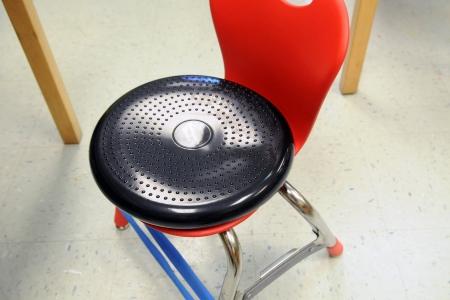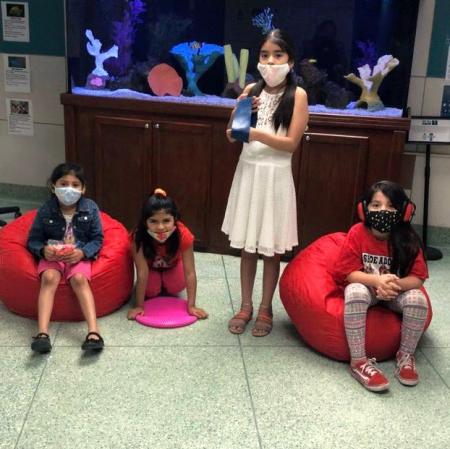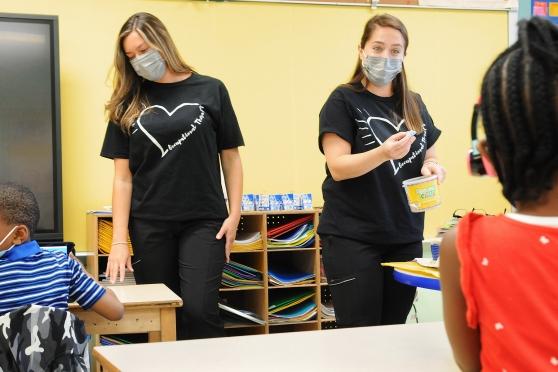From fidgeting to focusing

Teacher Melissa Curto works with a student, wearing headphones to block noise, as he completes a math lesson in her self-contained classroom at PS 45 on Staten Island.
Fidget spinners, foot fidgets, wiggle cushions and beanbag chairs have long been staples of the special education classroom. They are sensory tools designed to help students calm down and stay focused.
Ellaine Portillo, an integrated co-teaching instructor at PS 45 on Staten Island, said something as simple as rubber bands around the legs of a chair, or foot fidgets, can give students something to bounce off while seated. “It gets that jittery feeling out of them and helps them stay focused on their work,” she said.

A foot fidget band placed on front chair legs gives students something to bounce off while seated.
As schools prepare to welcome back students, including hundreds of thousands who worked remotely for more than a year, sensory tools are taking on new significance: They help students in general education ease back into the classroom routine. In September, more than 10,000 classrooms in 376 schools will receive Sensory Tool Kits, created by the Positive Learning Collaborative, for use in the general education classroom. New items, such as light filters and noise-reducing headphones, will also be included in the kits.
Dana Ashley, the director of the Positive Learning Collaborative, a joint initiative of the UFT and the city Department of Education, said her staff identified the high-needs schools that will receive the kits by factoring in ZIP codes that experienced high COVID-19 death rates, economic need and the most students in temporary housing. “Kids have been learning and studying on a bed, a couch or a kitchen table,” Ashley said. “Making the transition back to more traditional learning environments may be challenging for some students. These tools give kids control and agency.”

Wiggle cushions have long been a staple in the special education classroom.
The Positive Learning Collaborative was created to help schools ensure every child develops the social, emotional and academic skills needed to succeed in school and in life. City funding was supposed to help the program expand in middle schools. But once the pandemic shut down school buildings, the money instead was used to fund workshops and learning groups to help teachers recognize when students are experiencing stress, anxiety and grief during the pandemic and beyond. The Positive Learning Collaborative wanted to ensure that students also had the physical tools needed to create healing-centered classrooms. That goal led to the design of the sensory tools project.

Beanbag chairs, wiggle seats and bands are among the tools that help students relax and stay focused.
Farah Hotchkiss, an occupational therapist at PS 45, said her school was selected for a trial and received kits in June. “It’s nice to see it mainstreamed and accessible to other students,” she said.
“The kit has a little bit of everything because kids need different things,” said Melissa Curto, who teaches a self-contained class at PS 45 and has used some of the tools for years. “Some kids haven’t been in the classroom for a year and a half. This will help them adapt.”
Light filters, a novel addition to the kits, are new to Portillo, the integrated co-teaching instructor. “Kids have complained about bright lights,” she said, and “they have to be comfortable in their learning environment.”
The filter is “a blue sheet to place over the light fixture to reduce sensory overload,” she explained. “It’s a great way to modify the classroom without removing the child from the room.”

Occupational therapists Kaitlyn McEvoy (left) and Farah Hotchkiss work with students in the class
Portillo said she was excited to have the tools at her disposal this fall. “Just having these resources available is going to meet my students’ educational needs,” she said.